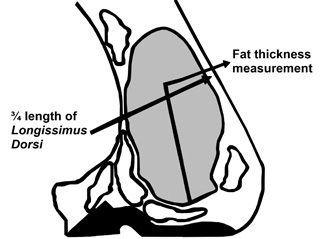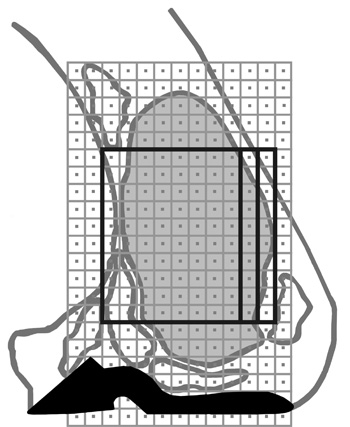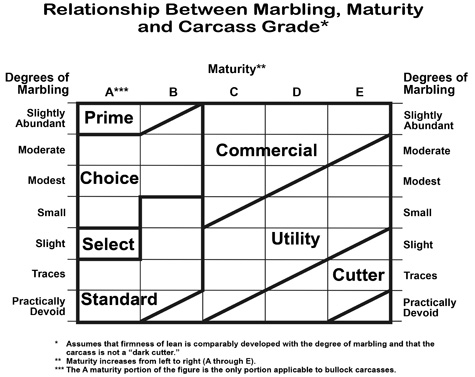What Does Marb Stand for in Beef Terms
Introduction
Many retained buying programs offer producers the opportunity to receive a level of information from the feed-yard and packing plant that is rarely available subsequently those animals get out the farm. I example is the Georgia Beef Challenge, which gives its participants data on cattle proceeds and carcass data. Table 1 shows an example of a carcass report received from the Georgia Beef Claiming.
Producers can utilise this information to make genetic changes in their herd to improve the marketability of their calves. To make calves more marketable producers must strive to meet industry targets:
| · | Hot carcass weight 600-800 lbs. | · | Yield Grade 2 or less |
| · | Fat Comprehend 0.3-0.45 inches | · | Quality Grade Select + to Pick |
| · | Rib-eye Surface area 12.5-14 sq inches |
All the same, before this information can be utilized, producers must sympathize what these terms mean. The terminology might exist slightly unlike on diverse reports, but the mutual ones used for herd improvements are discussed below.
Hot Carcass Weight (HCW) and Dressing Per centum (Dress %)
Hot carcass weight, or carcass weight on some reports, is the hot or united nations-chilled weight of the carcass after slaughter and the removal of the caput, hide, intestinal tract, and internal organs. The HCW is used to determine yield course and also dressing percentage. Dressing per centum is the percentage of the live creature that ends up as carcass. It is computed from the following formula:
Dress % = (HCW ÷ live weight) x 100%
Here is an example: A steer has a live weight of 1250 lbs. and afterward slaughter has a hot carcass weight of 792 lbs.
( 792 ÷ 1250 ) x 100% = 63.36%
He has a dressing percentage of 63.36 percentage.
The dressing percentage for beefiness cattle is normally sixty-64percent. Hot carcass weight is a major factor in determining total revenue when animals are sold on a grid. Pricing on a grid is a method of pricing slaughter cattle that offers premiums and discounts for carcasses. Cattle that are leaner and accept higher quality grades receive premiums. Grids generally take other specifications for carcass weight and nighttime cutters likewise. (Nighttime cutters refers to beef that is night to virtually black resulting in lower quality beefiness.) Price discounts usually occur for carcasses weighing less than 550 lbs. and more than 950 lbs. However, within the acceptable range for HCW, heavier carcasses result in greater returns.
Fat Encompass (BF or FT)
Fat cover, sometimes referred to every bit back fat or fat thickness, is the measure of the thickness of external fat on the carcass. Information technology is expressed in inches. This measurement is taken over the loin muscle (longissimus dorsi) of the calf between the 12th and 13th ribs at a signal three-fourths the length of the ribeye from the split chine bone. This measurement may exist adapted to reverberate unusual amounts of fat that are present on other parts of the carcass. Fat cover is another factor used to determine yield class. Figure 1 shows where the fat cover is measured.

Ribeye Area (REA)
Ribeye area is the measure out of the total area of the loin or ribeye (longissimus dorsi) between the 12th and 13th ribs. This measurement is expressed in foursquare inches and tin can exist measured using a grid. Ribeye area is likewise used in the determination of yield course. Figure 2 shows the grid used to measure ribeye area.

Percent Kidney, Pelvic, Heart Fat (%KPH)
% KPH is the percentage of full fat found in the trunk cavity of a carcass specifically in the regions of the kidneys, pelvis, and heart. It is oftentimes estimated visually past a USDA grader or it can be calculated based on the change in carcass weight following removal of fat from these areas on the carcass. Nigh carcasses have ane to 4 percent KPH. It is the last factor used to determine yield grade.
Yield Grade
The purpose of yield grades is to divide beefiness carcass into cutability groups based on the expected yield of boneless, closely trimmed, retail cuts (BCTRC) from the round, loin, rib and chuck. Yield grades are expressed as numeric scores 1-5, with ane having the greatest per centum of BCTRC and five the everyman. The relationship between BCTRC and yield grade is shown in Tabular array ii.
The factors used to summate yield grades include fatty cover (FC), hot carcass weight (HCW), ribeye area (REA), and percent kidney, pelvic, center fat (%KPH). The formula is as follows:
USDA Yield Class = ii.5 + (2.five x FC) + (0.0038 + HCW) + (0.ii x %KPH) – (0.32 ten REA)
Percent Retail Product (%RP)
Percent retail product is the proportion of the carcass that is trimmed, bone-in (or boneless) retail cuts. It is formulated past using the equation below.
% RP = retail cuts weight ÷ carcass weight (chilled) x 100
Marbling Score (Marb)
Marbling, or intramuscular fat, is the estimate of the amount of fat present in the loin / ribeye (longissimus dorsi) musculus. Graders evaluate the corporeality of intramuscular fat at the cut surface of the ribeye on the 12th rib surface. There are 9 marbling scores and each of these is divided into 100 subunits. They are assigned as subscripts to the scores ranging from 00 to 99, representing the least and greatest amount of marbling within the score.
| The marbling scores (least to greatest) are: | |
| i. | Practically Devoid (PD) |
| 2. | Traces (TR) |
| three. | Slight (SL) |
| 4. | Minor (SM) |
| 5. | Pocket-sized (MT) |
| 6. | Moderate (Doc) |
| 7. | Slightly Arable (SLAB) |
| 8. | Moderately Abundant (MDAB) |
| 9. | Abundant (AB) |
Degree of marbling in young cattle (< 30 mo.) is the primary determinant of quality course.
Quality Course
The purpose of quality grades is to segregate beef carcasses into palatability groups based on the expected eating quality. Quality grades are based on degree of marbling and carcass maturity. Carcass maturity groups range from A to E and are an estimate of the animal'due south historic period from which the carcass was derived. Maturity grouping A cattle are estimated to be between 9 – 30 months old, while grouping E cattle are greater than 96 months. The quality grades are (from most palatable to to the lowest degree) Prime, Pick, Select, Standard, Commercial, Utility, Cutter, and Canner. The human relationship between marbling, maturity and quality grades are shown in Figure 3.

Summary
Agreement the data provided on a carcass data report is vital to being able to utilise information technology to make improvements in the herd. Beef is the ultimate product in cattle production and making that production meliorate and coming together the demands of packers and consumers volition ensure a college profit for producers. Co-ordinate to the 2005 National Beef Quality Audit these are the goals that producers need to strive for:
i. Deliver product attributes that meet consumer needs/expectations for prophylactic, taste, colour and convenience.
2. Amend cattle past implementing instrument grading; reducing numbers of YG 4 or 5 carcasses; decision-making carcass weight; increasing marbling; decreasing variation, and maximizing profitability.
iii. Aggrandize marketing opportunities (in domestic and global markets) past developing traceability systems; verifying source and age; reducing costs and waste material in the beef value chain, and continuing new product development.
Only with proper understanding of carcass information reports can producers achieve these goals and be more than prepared to run across industry targets.
1County Extension ANR Agent - Bulloch Canton
Condition and Revision History
Published on Feb 28, 2007
Published on Feb 04, 2009
Unpublished/Removed on Mar 01, 2010
Published on Sep 10, 2010
Published with Full Review on Sep 11, 2013
Published with Full Review on Jan 05, 2017
Published with Full Review on Jan 05, 2017
Source: https://extension.uga.edu/publications/detail.html?number=B1326&title=Understanding+Beef+Carcass+Reports
0 Response to "What Does Marb Stand for in Beef Terms"
Post a Comment